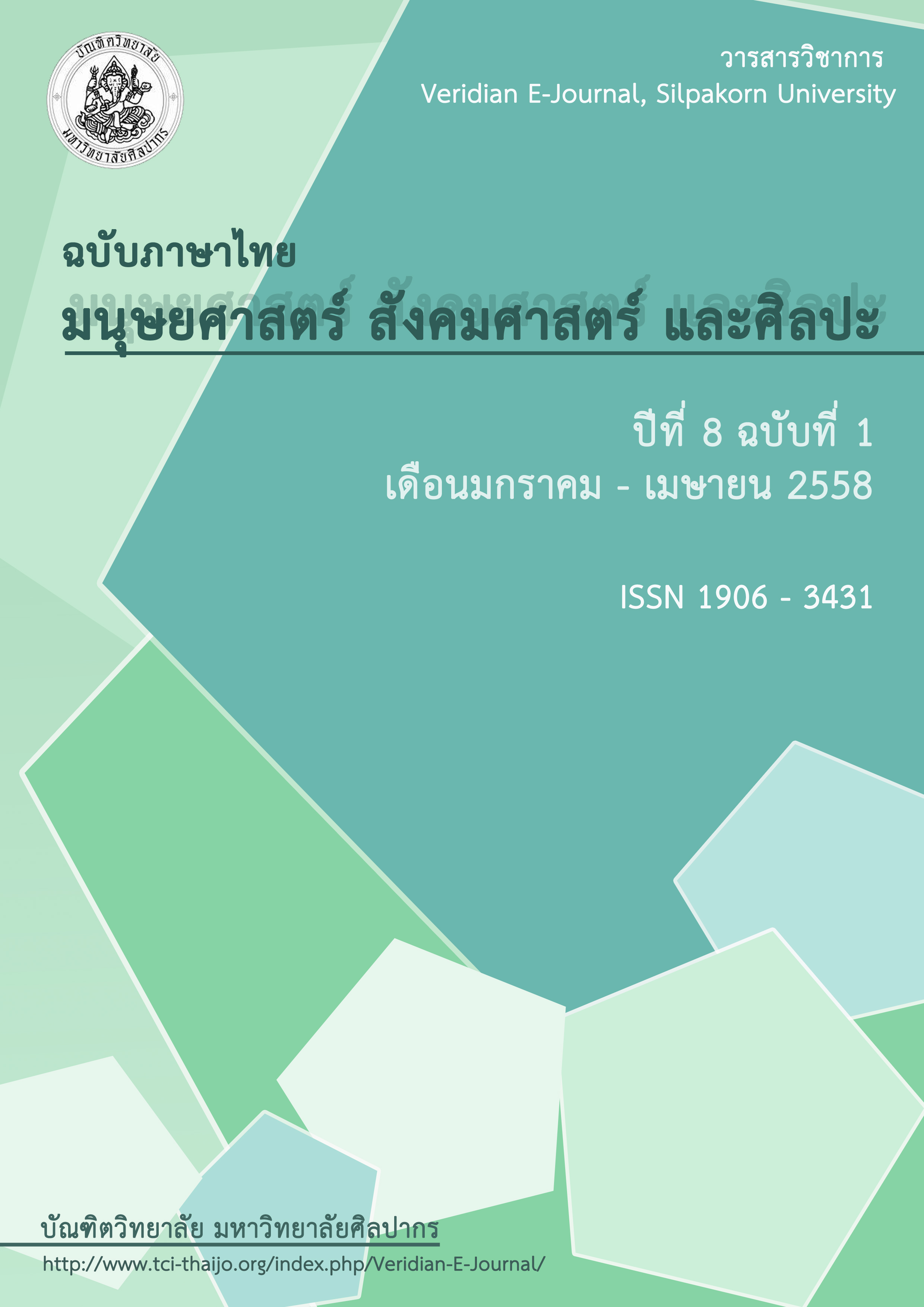การพัฒนารูปแบบการบริหารงานวิชาการของมหาวิทยาลัยมหามกุฏราชวิทยาลัย ในสังคมอนานคต
Main Article Content
Abstract
บทคัดย่อ
การวิจัยครั้งนี้เพื่อศึกษาข้อมูลพื้นฐานและการพัฒนารูปแบบการบริหารงานวิชาการของมหาวิทยาลัยมหามกุฏราชวิทยาลัยในสังคมอนาคต ตามขอบข่าย ดังนี้ 1.การพัฒนาหลักสูตร 2.การพัฒนากระบวนการเรียนรู้ 3.การวัดผลประเมินผลและการเทียบโอน 4.การวิจัยเพื่อพัฒนาคุณภาพการศึกษา 5.การพัฒนาสื่อ นวัตกรรมและเทคโนโลยีเพื่อการศึกษา 6. การพัฒนาแหล่งเรียนรู้ 7.การพัฒนาการนิเทศและแนะแนว 8.การพัฒนาระบบการประกันคุณภาพ 9.การบริหารความเสี่ยง 10.การส่งเสริมความรู้ทางวิชาการแก่ชุมชน 11.การประสานความร่วมมือทางวิชาการกับสถานศึกษาอื่น
ข้อมูลที่ได้นำไปใช้ในการกำหนดแผนจัดการศึกษา โครงการและกิจกรรมเพื่อการพัฒนาผู้เรียนในสังคมอนาคต วิธีวิจัยใช้แบบผสม ระหว่างวิธีวิจัยเชิงปริมาณ และวิจัยเชิงคุณภาพ ดังนี้ 1) เลือกกลุ่มตัวอย่างแบบเจาะจง เพื่อสำรวจความต้องการพื้นฐานจากบุคลากรที่เป็นอาจารย์ เจ้าหน้าที่ และนักศึกษา จำนวน 100 รูป/คน 2) นำข้อมูลพื้นฐานที่ได้มาทำ SWOT Analysis กับกลุ่มตัวอย่างที่เป็นผู้บริหาร คณาจารย์ ซึ่งเป็นกรรมการสภาวิชาการ จำนวน 50 คน 3) นำผลที่ได้จากการสำรวจความต้องการพื้นฐานและการทำ SWOT Analysis มาสำรวจความคิดเห็นด้านการบริหารงานวิชาการจากกรรมการสภาวิชาการผู้มีประสบการณ์ในการบริหารและมีพลังอำนาจในการเปลี่ยนแปลงที่เป็นผู้เชี่ยวชาญ จำนวน 21 คน เก็บข้อมูลด้วย โดยใช้แบบสอบถามปลายปิดแบบมาตราส่วนประเมินค่าห้าระดับ
ผลการวิจัย พบว่า
ตอนที่ 1. สำรวจความต้องการของบุคลากร ที่เป็นอาจารย์ เจ้าหน้าที่ และนักศึกษา จำนวน 100 คน รูป/คน ใน 4 ด้าน คือ ด้านที่ 1 สภาพที่เป็นอยู่จริงในการพัฒนาหลักสูตร ด้านที่ 2 การตรวจสอบและควบคุมคุณภาพ ด้านที่ 3 ด้านความร่วมมือส่งเสริมการเรียนรู้ และด้านที่ 4 ความคาดหวังที่ต้องการให้เกิดในอนาคต ซึ่งด้านที่ 1, 2 และ 3 อยู่ในระดับน้อยที่สุด และระดับปานกลาง ด้านที่ 1,2,3 ด้านไหนอยู่ในระดับน้อยที่สุด และระดับปานกลาง) ส่วนด้านที่ 4 อยู่ในระดับมากที่สุด ส่วนด้านความคาดหวังต่อการพัฒนารูปแบบการบริหารงานวิชาการโดยรวมทั้ง 3 ด้าน ค่า PNI Modified พบว่าคือ ด้านการตรวจสอบและการควบคุมคุณภาพ มีความแตกต่างมาก มีค่าเท่ากับ 0.42 รองลงมาคือ ด้านความร่วมมือส่งเสริมการเรียนรู้ มีความแตกต่าง มีค่าเท่ากับ 0.42
ตอนที่ 2. การทำ SWOT ANALYSIS กับผู้บริหาร คณาจารย์ 50 รูป/คน ได้ผลดังนี้ 1.จุดแข็งของมหาวิทยาลัยมหามกุฏราชวิทยาลัย คือ 1) ในทุกหลักสูตร และทุกระดับการศึกษามีวิชาพระพุทธศาสนาบรรจุไว้ 2) ผู้สำเร็จการศึกษาจากมมร. มีความรู้ ความเชี่ยวชาญด้านพระพุทธศาสนา 2.จุดอ่อน คือ 1) ผู้เชี่ยวชาญทางด้านการพัฒนาหลักสูตรมีจำกัด 2) การวัดผลประเมินผลและเทียบโอนขาดคุณภาพ 3) บุคลากรขาดความชำนาญเกี่ยวกับการใช้เทคโนโลยี 3.โอกาส คือ 1) จัดอบรมด้านวิชาการ และอบรมเชิงปฏิบัติด้านวิชาการบ่อยขึ้น 2) ช่วยงานคณะสงฆ์ในการจัดการศึกษาของคณะสงฆ์และร่วมมือกับคณะสงฆ์ในการพัฒนาหลักสูตรให้ตรงกับความต้องการของผู้ใช้บัณฑิต 3) ฝึกฝนบุคลากรให้มีประสิทธิภาพ 4.ข้อจำกัด (ภัยคุกคาม) 1) ผู้มีความรู้และแตกฉานด้านการพัฒนาหลักสูตรมีน้อย 2) หลักสูตรที่เปิดสอนมีน้อย ไม่ตรงกับความต้องการของตลาดแรงงาน 3) สถาบันขาดความน่าเชื่อถือจากการเปลี่ยนแปลงผู้บริหารบ่อย 4) ความเจริญก้าวหน้าและการเปลี่ยนแปลงระบบเทคโนโลยีเกิดขึ้นอย่างรวดเร็ว
ตอนที่ 3 ความคิดเห็นจากผู้เชี่ยวชาญ 21 รูป จาก 3 กลุ่มงาน 4 ด้าน ดังนี้ กลุ่มงานที่ 1 ด้านที่ 1 การพัฒนาหลักสูตร ด้านที่ 2 การพัฒนาระบบการเรียนการสอน ด้านที่ 3 การพัฒนาสื่อ นวัตกรรม และเทคโนโลยีเพื่อ และด้านที่ 4 การวัดผลประเมินผลและการเทียบโอน กลุ่มงานที่ 2 ด้านที่ 1 การวิจัยเพื่อพัฒนาคุณภาพการศึกษา ด้านที่ 2 การพัฒนาแหล่งเรียนรู้ ด้านที่ 3 การพัฒนาการนิเทศและแนะแนว และด้านที่ 4 การพัฒนาระบบประกันคุณภาพ กลุ่มงานที่ 3 ด้านที่ 1 การส่งเสริมความรู้ทางวิชาการแก่บุคลากร ด้านที่ 2 การส่งเสริมความรู้ทางวิชาการแก่ครอบครัว ด้านที่ 3 การส่งเสริมความรู้ทางวิชาการแก่ชุมชน และด้านที่ 4 การประสานความร่วมมือทางวิชาการกับสถานศึกษาอื่น ซึ่งทั้งหมดอยู่ในระดับมากที่สุด (ค่ามัธยฐาน 5.0) และมีความสอดคล้องกันโดยค่าพิสัยระหว่างควอไทล์ไม่เกิน 1.5
ABSTRACT
The main objectives of research were to study the common data and development of Mahamakut Buddhist University academic administration model for the future in the following areas: Curriculum development Learning process development Assessment and audit transfer Research for academic qualification development Educational media, innovation and technology development Learning center development Assessment and guidance development Educational quality assurance development Risk management Public academic services Academic memorandum with other academic institutes Expects towards development of Mahamkut Buddhist University: academic administration model for future, in the whole view of 3 aspects, “PNI Modified” was found that Quality check and monitoring was very different with the number of 0.42. The following aspect was the collaboration in learning being different with the number of 0.42.
The statistical data collected were to specify educational administration plans, project plans, and activities to develop students in the future. The methodology of this research is a mix method research between Quantitative Research and Qualitative Research. There was a sampling of 100 instructors, academic staff and students using the Purposive method. The SWOT Analysis was analyzed by 50 of the administrators and instructors. The data were collected by Delphi, a statistician. The technique employed questioned 21 academic experts of the MBU council, having experience in administration and the power to make a new academic model. The instrument for gathering data was the five-level rating scale closed end questionnaire.The results were found as follows:The first part was the result of survey of basic needs from academic staff or stakeholders in four aspects The realistic scenario of curriculum development Quality check and monitoring The collaboration in learning promotion The future realistic optimistic scenario in academic administration in which three of these were found to be in the lowest level and medium level, while the last one was in the highest level.
The second part was the result of SWOT Analysis by 50 of the administrators and instructors. It was found that the strengths of MBU were: Every program and all education levels contain Buddhist subjects for students to study The university’s educated students were well leaned in Buddhism The weaknesses were: The limit of curriculum development experts, 2) the evaluation and audit transfer were lack of quality The university’s academic staff were lack of knowledge in using technology;
The threats were : Lack of academic learned and experts, A few programs were available for students to choose which could not be responsible for Thai labor market The institute was lack of reliability because of the often administration changes The technology systems were rapidly progressed and changed; The opportunities were : To hold academic training and practice projects more often To support Sangha (Buddhist monks) council in education administration and to cooperate with the Sangha to develop academic programs responding to the needs of employers of MBU’s graduates.To train high-quality academic staff
The third part was the result of the opinion of 21 academic experts from 3 divisions in 4 different aspects: The opinion of the first division in: Curriculum development Learning process development Media, educational innovation and technology development Evaluation and audit transfer The opinion of the second division in: Research for academic qualification development Learning center development Assessment and guidance development Educational quality assurance development
The opinion of the third division in: Personnel academic learning promotion Family academic learning promotion Public academic learning promotion Academic memorandum with other academic institutes in which it was found that all the aspects were in the highest level (the overall median values were at 5.0) and had the relationship of Interquartile range values of not more than 1.5.
